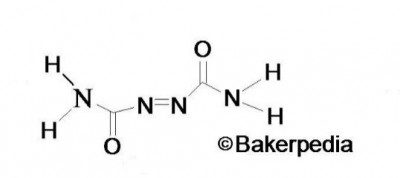
Azodicarbonamide (ADA) is used as a whitening agent in cereal flour and as a dough conditioner in bread baking.1 Introduced by Wallace and Tiernan INC. for use with plastics and rubber, ADA was approved for use as a food additive by U.S. Food and Drug Administration in 1962.
In response to consumer health concerns, Subway removed ADA from its bread in all U.S. locations. Is bread made with Azodicarbonamide safe?

Figure 1: Azodicarbonamide molecular.
ADA reactions during baking
Whether ADA is our friend or foe can be illustrated by two reactions.
Reaction 1:
- ADA is mixed into dough
- ADA oxidizes the sulfhydryl (SH) groups and exerts an improving effect
- The main reaction product is biurea
The bread made from ADA-treated flour is characterized by increased loaf volume, improved grain texture, and improved outside appearance. The oxidation is rapid and almost complete during the mixing of dough for 2.5 min. Further mixing or prolonged resting give an additional decrease in the –SH content.
ADA is used where a faster maturing agent is required. Treatment levels ranging from 2 to 45 p.p.m. of ADA are required to accomplish maturing, with the amount depending on the grade of flour.2

Figure 2: Azodicarbonamide oxidizes the sulfhydryl (SH) groups in dough (the maturing action of ADA).
Reaction 2:
- Biurea and ADA could hydrolyze to form semicarbazide (SEM) when high temperature is applied.

Figure 3: Biurea is degraded to semicarbazide during baking.
ADA and SEM
SEM was detected in a variety of commercially available bread products and ADA was established to be the source.4-5
Noonan (2008)3 studied the formation of SEM during bread baking and confirmed that SEM formed at the high temperature baking process, not at the rising process. SEM formation is from biurea, since ADA is fully converted to biurea 45 min after the addition of water.
Ye (2011)6 found that the amount of SEM in bread is linear to the amount of ADA added to flour. When the concentration of the injected ADA is 20 mg/kg, the concentration of SEM is 0.012 mg/kg. While the concentration of the injected ADA is 30 mg/kg, the concentration of SEM is 0.022 mg/kg.
ADA safety
SEM has been classified by The European Food Safety Authority (EFSA) as a weak, nongenotoxic carcinogen.7 It is listed as zero tolerance contaminant in food and animal feed in the article Heberer (2007).7
Maranghi (2009)8 studied the effects of SEM in juvenile Sprague-Dawley rats and found that at the dosage of 40 mg/kg body weight per day during the juvenile period in male Sprague-Dawley rats, histological alternations were observed in all tissues including ovary, uterus, thyroid, thymus, spleen, adrenals. Maranghi’s research (2010)9 showed the toxicological effects of SEM as an endocrine modulator in male and female rats after oral administration in vivo experiment for 28 days at 40 mg/kg body weight per day during the juvenile period of rats.
ADA is banned in Australia and Europe as a food additive6 In Singapore, use of ADA can result in up to 15 years imprisonment and a fine of $450, 000.6 In 2005, the EFSA assessed the risk from the use of ADA as a blowing agent and concluded that it is not of concern for human health given the levels that have been found in foods packaged in glass jars and bottles. However, EFSA had also noted that exposure to SEM should be limited where possible, and the European Union banned the use of ADA.10
ADA is still used in Brazil and Canada.11 In the US, ADA has a generally recognized as safe (GRAS) status and is allowed to be added to flour at levels up to 45 ppm.1 But, ADA must be declared in the statement of ingredients.10 FDA has claimed it will continue to evaluate the safe use of ADA in foods and considers ADA as a safe food additive when used for the purposes and at the levels specified in the FDA regulations.10
References
- “21CFR172.806.” CFR – Code of Federal Regulations Title 21.
- R. R. Joiner, F. D. Vidal, and H. C. Marks. A new powdered agent for flour maturing. Cereal Chemistry. 40: 539-553.
- Noonan, Gregory O., Timothy Begley H., and Gregory Diachenko W. “Semicarbazide Formation in Flour and Bread.” J. Agric. Food Chem. Journal of Agricultural and Food Chemistry 56.6 (2008): 2064-067.
- Noonan, Gregory O., Charles R. Warner, Wenchi Hsu, Timothy H. Begley, Gracia A. Perfetti, and Gregory W. Diachenko. “The Determination of Semicarbazide (N-Aminourea) in Commercial Bread Products by Liquid Chromatography−Mass Spectrometry.” J. Agric. Food Chem. Journal of Agricultural and Food Chemistry 53.12 (2005): 4680-685.
- Becalski, A., B. P.-Y. Lau, D. Lewis, and S. Seaman. “Semicarbazide in Canadian Bakery Products.” Food Additives and Contaminants 23.2 (2006): 107-09.
- Ye, Jing, Xiang-Hong Wang, Ya-Xin Sang, and Qian Liu. “Assessment of the Determination of Azodicarbonamide and Its Decomposition Product Semicarbazide: Investigation of Variation in Flour and Flour Products.” J. Agric. Food Chem. Journal of Agricultural and Food Chemistry 59.17 (2011): 9313-318.
- Heberer, T., M. Lahrssenwiederholt, H. Schafft, K. Abraham, H. Pzyrembel, K. Henning, M. Schauzu, J. Braeunig, M. Goetz, and L. Niemann. “Zero Tolerances in Food and Animal Feed–Are There Any Scientific Alternatives? A European Point of View on an International Controversy.” Toxicology Letters 175.1-3 (2007): 118-35.
- Maranghi, F., R. Tassinari, V. Lagatta, G. Moracci, C. Macrì, A. Eusepi, A. Di Virgilio, M.l. Scattoni, and G. Calamandrei. “Effects of the Food Contaminant Semicarbazide following Oral Administration in Juvenile Sprague–Dawley Rats.” Food and Chemical Toxicology 47.2 (2009): 472-79.
- Maranghi, Francesca, Roberta Tassinari, Daniele Marcoccia, Ilaria Altieri, Tiziana Catone, Giovanna De Angelis, Emanuela Testai, Sabina Mastrangelo, Maria Grazia Evandri, Paola Bolle, and Stefano Lorenzetti. “The Food Contaminant Semicarbazide Acts as an Endocrine Disrupter: Evidence from an Integrated in Vivo/in Vitro Approach.” Chemico-Biological Interactions 183.1 (2010): 40-48.
- “Frequently Asked Questions on Azodicarbonamide (ADA).” www.fda.gov. N.p., 25 Apr. 2016.
- Mulder, P.p.j., B. Beumer, and J.a. Van Rhijn. “The Determination of Biurea: A Novel Method to Discriminate between Nitrofurazone and Azodicarbonamide Use in Food Products.” Analytica Chimica Acta 586.1-2 (2007): 366-73.
- “21CFR101.4(a)(1)” CFR – Code of Federal Regulations Title 21.

